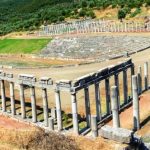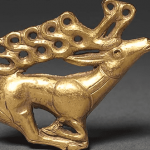 Movies and TV
Movies and TV  Movies and TV
Movies and TV  Humans
Humans 10 Times Scientists Were Absolutely Sure… and Absolutely Wrong
 Our World
Our World 10 Pivotal Moments for Life on Earth
 Movies and TV
Movies and TV 10 Most Realistic Medical TV Shows of All Time
 Creepy
Creepy 10 Eerie & Mysterious Ghosts of the Pacific Coast
 Weird Stuff
Weird Stuff 10 Typos That Accidentally Changed History
 History
History 10 Times Trickery Won Battles
 Technology
Technology 10 Awesome Upgrades to Common Household Items
 Misconceptions
Misconceptions 10 Hilarious (and Totally Wrong) Misconceptions About Childbirth
 Weird Stuff
Weird Stuff 10 Warning Labels That Exist Because Someone Actually Tried It
 Movies and TV
Movies and TV 10 Zombie Movies That Will Actually Terrify You
 Humans
Humans 10 Times Scientists Were Absolutely Sure… and Absolutely Wrong
 Our World
Our World 10 Pivotal Moments for Life on Earth
Who's Behind Listverse?

Jamie Frater
Head Editor
Jamie founded Listverse due to an insatiable desire to share fascinating, obscure, and bizarre facts. He has been a guest speaker on numerous national radio and television stations and is a five time published author.
More About Us Movies and TV
Movies and TV 10 Most Realistic Medical TV Shows of All Time
 Creepy
Creepy 10 Eerie & Mysterious Ghosts of the Pacific Coast
 Weird Stuff
Weird Stuff 10 Typos That Accidentally Changed History
 History
History 10 Times Trickery Won Battles
 Technology
Technology 10 Awesome Upgrades to Common Household Items
 Misconceptions
Misconceptions 10 Hilarious (and Totally Wrong) Misconceptions About Childbirth
 Weird Stuff
Weird Stuff 10 Warning Labels That Exist Because Someone Actually Tried It
10 Ways We’re All Picturing The Ancient World Incorrectly
Thanks to countless books, movies, and trashy TV shows, most of us have a fairly firm mental image of the ancient world. Togas, feasting, gladiatorial combat . . . the standard stuff. Yet step back in time, and you’d be confronted with a world that confounded your expectations. Far from being a close approximation of the truth, our collective mental image of the ancient world may be nothing like reality at all.
10Ancient Britain Had African Citizens

Although London is one of the most multicultural cities on Earth, it’s only been in the last century or so that minorities have become a familiar sight in Britain. Go back a millennium, and everyone would be lily white, right? Not quite. Britain has had black citizens for at least 1,800 years.
In 2010, researchers at Reading University found evidence that Roman York had been home to individuals of North African descent. One of them, dubbed “the iron bangle lady,” was found buried with enough jewelry to mark her out as distinctly upper-class, suggesting she wasn’t simply a traveler or slave. But even the iron bangle lady pales in comparison to ancient York’s most famous African citizen. In AD 208, the Libyan-born Roman emperor Septimius Severus made the city his base, ruling the Empire from there until his death three years later.
This multicultural history didn’t end with the fall of Rome. Records show small communities of black people living in Britain from the 12th century onward, with at least one skeleton identified as having predated the 1066 arrival of William the Conqueror. By 1501, Catherine of Aragon was bringing over her vast retinue of Muslims, Jews, and North Africans, plenty of whom settled in Britain. Far from being a modern phenomenon, Britain has been multicultural for nearly its entire existence.
9Neanderthals Were Seriously Intelligent

“Neanderthal” is a synonym for “idiot,” a reminder that before we became kings of the planet, we first had to wipe out our stupider cousins. You can’t get a much more classic image of the ice age than a Neanderthal being flummoxed by some Homo sapiens ingenuity. That image isn’t entirely accurate. All available evidence points to our Neanderthal cousins being just as intelligent as we are.
In 2014, researchers uncovered evidence that Neanderthals in northern Europe hunted by herding mammoths and bison into a deep ravine. Such a logistically complex operation would require communication and planning abilities at least as advanced as those of our ancestors. There’s also plenty of evidence that Neanderthal tools were as advanced as human ones, using bones, flints, and homemade adhesives to create perfect weapons.
We’ve also found signs of Neanderthal culture. Archaeologists recently discovered ornaments and pigments for body painting, suggesting complex religious rituals. There’s even a cave in Gibraltar containing primitive Neanderthal art.
8Ancient Egypt Had No Jewish Slaves

One of the earliest Bible stories any of us get taught is the Exodus. After centuries of slavery in Egypt, the Jews finally manage to escape with the help of some timely plagues. Although only a handful today believe the literal truth of the story, most assume it at least has some basis in fact. Go back in time 4,000 years and the Sinai Desert would be full of wandering ex-slaves, right?
The archaeological record says otherwise. We haven’t uncovered a single shred of evidence that indicates 600,000 Jewish families spent time in the desert. Considering we have evidence for much smaller nomadic groups once living there, this absence is significant. Nor have we found anything in Israel that would suggest a large influx of migrants in ancient times.
The Egyptian state kept meticulous records of everything that happened, including migration by minor nomadic groups. Had most of their slaves, accounting for one-quarter of their entire population, suddenly fled, there would at least be records documenting labor shortages and a major economic crash. No such records have ever been found.
Incidentally, the ancient Egyptians treated their slaves better than most cultures. Many were simple debt slaves, who had sold themselves to pay back money and had a fixed end term to their servitude. In certain circumstances, they were even better off than free peasants. This was a departure from the Bible’s depiction of the Egyptians as cruel tyrants.
7The Romans Had Laws Against Eating And Partying Too Much

Alongside their penchant for cruelty, Romans are known for their commitment to partying. Even if we’re aware the story about eating until they vomited is totally false, we probably still imagine a Roman party as piles of food and lots of wine.
Unfortunately for any party animals now powering up their time machines, the Roman state had limited interest in hedonism. Throughout the history of the Republic, dozens of sumptuary laws were passed with the express purpose of limiting what private citizens could spend on having fun. In 81 BC, Sulla passed a law severely regulating the expenses of entertainments. A few years later, another law set out the kind and quantity of food that could be used. Other laws did everything from restricting spending at banquets to forbidding people from eating at each other’s houses.
While these laws weren’t always observed, they were sometimes brutally enforced. Under Julius Caesar, soldiers broke up banquets and monitored people’s spending in the markets. It wasn’t until after Nero’s time that the laws were finally discarded as unworkable and ordinary Romans could legally indulge their enormous appetites.
6Stonehenge Was Gigantic

An ancient circle of rocks in the heart of the English countryside, Stonehenge has been overwhelming visitors with its sense of isolation for centuries. Seemingly unchanged since the day it was built, it’s today an icon of mystery and solitude.
This reputation for peace is probably undeserved. Back in prehistoric times, Stonehenge was surrounded by a gigantic, bustling metropolis.
In 2014, a group of scientists completed the biggest survey of the Stonehenge historical area in history. Aside from a gigantic similar collection of stones only 3 kilometers (2 mi) away, the team uncovered evidence of chapels, burial mounds, and ritual shrines sprawling over acres of land. There were even traces of important nearby settlements where tribes would gather in large numbers, so ancient Stonehenge was probably always busy.
Strangely, the team also found evidence of other henges and religious sites being constantly knocked down, built up in new ways, and knocked down again. Far from being constructed to some grand plan, ancient Stonehenge was constantly evolving.
5Brontosaurus Really Did Exist

For a whole generation of dinosaur fans, nothing sets their teeth on edge more than the word “brontosaurus.” It’s been known since 1903 that the man who discovered the thunder lizard, O.C. Marsh, was simply misidentifying some old Apatosaurus bones. Thanks to his clumsy mistake (plus Stephen Spielberg), schoolkids are today enamored with a dinosaur that never existed.
At least, they were until April 2015, when scientists decided Brontosaurus really did exist after all.
In a 300-page study, researchers from the New University of Lisbon in Portugal analyzed over 81 different sauropod bones and concluded there were enough differences for Brontosaurus to count as a different species. Although nearly identical to the Apatosaurus, it had a slightly narrower and higher neck. This small difference was varied enough for the researchers to identify three separate species within the Brontosaurus genus, taking its known family tree in a single paper from nonexistent to crowded.
They even noted that many famous Apatosaurus specimens (including the one at the American Museum of Natural History) may now have to be studied and reclassified as another species entirely. O.C. Marsh, we owe you an apology.
4A Palaeolithic Diet Was Nothing Like You’d Expect

You may have heard of the Paleo Diet. The fad says we should eat only what our ancient ancestors could have eaten, which means stocking up on meat, cutting out the grains, and dropping the Big Macs. Yet our ancestors really didn’t eat like that at all.
Take flour. The Paleo Diet is generally quite strict about its followers dropping bread, considering it “non-Paleo” because agriculture didn’t arise until after 10,000 years ago (the diet’s cutoff point). But in 2010, researchers uncovered traces of 30,000-year-old flour on grinding stones in both Italy and the Czech Republic. There are other differences, too. While most of us probably assume our ancestors ate a whole load of mammoth meat, National Geographic recently concluded they probably only did so rarely, when the hunting was good.
Finally, all plants and animals have evolved so much in the last 10,000 years that any attempt to perfectly replicate ancient diets is futile. We’ve selectively bred crops and livestock into such different forms that our ancestors wouldn’t even recognize them.
3The Silk Road Was About Far More Than Trade

A network of trading routes stretching from modern Italy all the way to Indonesia, the Silk Road is an icon of ancient commerce. Just hearing its name can still conjure images of lonely merchants battling their way over inhospitable terrain to the remotest reaches of the known world.
Yet the Silk Road was about far more than simple trading. Alongside the merchants, you could find everyone from Buddhist monks to spies to artists to refugees.
For our ancestors, the Silk Road brought much more than simple silk. In a world without newspapers, television, or the Internet, it was many communities’ only lifeline to the rest of the human race. The people moving along its length brought news, ideas, gossip, and even fashion tips. It was also responsible for spreading religious thought. Buddhism’s position today as a major religion of Asia is almost entirely due to monks walking along the Silk Road, preaching enlightenment to everyone they passed.
Equally as important were the refugees. Although we rarely picture the Silk Road as a path for people fleeing oppression, it was swamped with them. This human tide brought learning, technology, and cultural exchange in its wake. They may be what we commonly think of, but merchants were simply a footnote in the Silk Road’s history.
2Ancient China Practiced Human Sacrifice

Think of human sacrifice, and you probably picture bloodthirsty Aztecs or Maya killing people to ensure the Sun came up. Yet another, unlikelier culture practiced human sacrifice: ancient China.
The ancient Chinese were as violent as they come. In 2007, archaeologists dug up a mass grave filled with the bodies of 47 people sacrificed so they could continue to serve their master in the next world. Early writings from the Shang era contain reference to 37 different categories of blood sacrifice, causing some to claim the entire pre-modern Chinese state was built on sacrifice.
Unlike the very early sacrifices of Greece and Rome, the practice also carried on until relatively recently. As late as the early Ming Dynasty (1368–1644), imperial consorts were being sacrificed when their emperor died. Chinese society was killing people for religious purposes as late as the voyage of the Mayflower.
1Rome Persecuted Loads Of Religions (Not Just Christians)

The story of the early martyrs persecuted by the Romans is one of Christianity’s founding myths. By showing they would rather die than renounce their God, the nameless victims inspired generations of future Christians. Yet there’s one part of the story these inspirational tales always leave out. Christians were no more persecuted than other religions in Rome.
While Nero hated Christians with a deadly passion, plenty of other emperors hated other cults just as strongly. In 186 BC, the Senate passed extreme laws clamping down on the freedom of the Bacchus cult, a new religion focused on the worship of Dionysus. Like the Christians after, the Bacchus cult’s members were slandered and depicted as heretics and enemies of the state. They were also viciously oppressed. During the crackdown, Livy claimed many cult members were tortured, and far more were executed for their offenses than simply imprisoned.
They weren’t the only ones. The Druids, too, were later targeted by the Roman state for annihilation, as were the Jews. There were even periods before Constantine’s conversion when persecution of the Christians briefly halted, even as other religions were being targeted. Rather than being marked out for special ill treatment, the Christians were simply one of many cults who managed to get on the Romans’ bad side.








